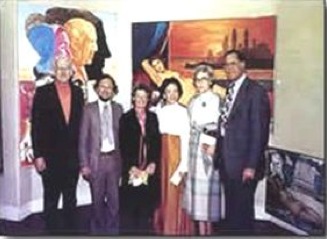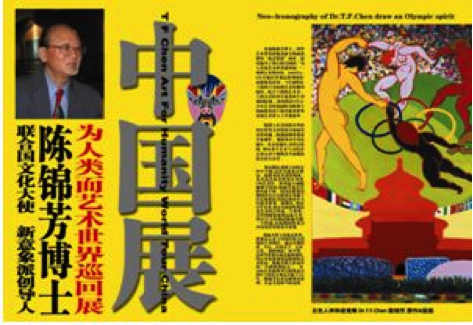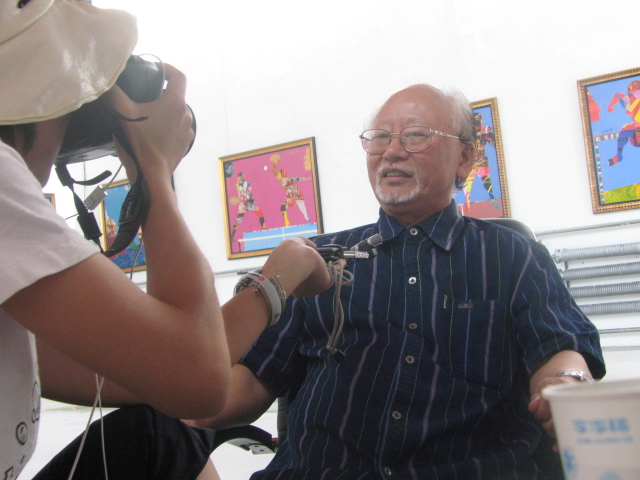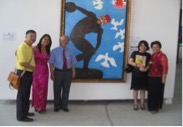Uncategorized
Encountering Dr. Tsing-Fang Chen
By Lawrence Jeppson
 Dr. Chen’s first exhibition in the U.S. at the Art Alliance in Philadelphia, 1978. Mr. Lawrence Jeppson (far left) coined the term “Neo-Iconography” for Chen’s artistic style and wrote extensively on it.
Dr. Chen’s first exhibition in the U.S. at the Art Alliance in Philadelphia, 1978. Mr. Lawrence Jeppson (far left) coined the term “Neo-Iconography” for Chen’s artistic style and wrote extensively on it. |
As an international art critic, consultant, and market appraiser, I have placed my reputation and advocacy fully behind Dr. T.F. Chen for more than thirty years.I first met Dr. T.F. Chen in 1973 at an exciting turning point in both our lives. Chen had just spent a dozen years in Paris where he had obtained a Ph.D. in Art History from the Sorbonne and had just created a new art style that reconciled the many and often contradicting paths of Oriental and Western art. I was an organizer of traveling art exhibitions, friend of many French and American artists, writer, lecturer, and scholar/curator/expert on certain artists and forms of art. Chen was just beginning this momentous, creative melding of those technical and philosophical differences between Western and Eastern art. He was doing this by carefully taking images from these disparate cultures and marrying them with paint on canvas. The images were quotes, but the way he reconstructed and juxtaposed them and the way he manipulated brush and pigment were all his own. I imme-diately recognized his great talent, bursting on so many levels. Chen came onto the New York scene shortly after Pop Art had blossomed and taken root as one of the new American gallery dramas. |
I remember as a young boy memorizing every worn page of the 50 art books that a local dentist had smuggled in from Japan. At 14 years old, upon seeing the art of Vincent van Gogh for the first time, I wept and set my will upon going to Paris and becoming an artist. I consumed everything relating to fine art, literature, or music in that impoverished time and fed my soul with their beauty…Immersing myself in even the little bit of art that was available at that time made me into a passionate, intelligent, creative man with a great love and keen sensibility towards our humanity.
Dr. Chen graduated in 1950 from the National Taiwan University, where he was president of the Association of Fine Arts. Realizing his dreams, he went to Paris in 1963 on a coveted fellowship from the French government. He spent the next 12 years studying, painting, and exhibiting in France. He obtained a Master's degree in French Contemporary Literature and a Doctorate, summa cum laude, in Art History from the Sorbonne. During this deeply intellectual period, he simultaneously studied at L’École Nationale Supérieure des Beaux-arts for 7 years. In 1975, Chen and his wife Lucia moved from Paris to NYC and became US citizens. In1983, they moved to the SoHo art district of New York City. Chen says,With a mixture of Asian, European, and American influences, I grew up very conscious of being a 'World Citizen.' This kind of conscious awakening in the individual paves a way for a Global Culture based on Love, Peace, and Tolerance for all.
Dr. Chen has a vision of world civilization arriving at a harmony of peace and understanding, but he also sees a world beset with problems that first must be overcome. He seeks to harmonize Western logic and science with Eastern intuition and simplicity. In doing so, his images emerge as a rapturous, turbulent integration of the visuals of Formosan folklore, Chinese culture, Oriental art, and at least five centuries of unrolling, often conflicting Western traditions. Dr. Chen has created such a large, varied, and powerful body of art that he can stand alone as one of the most significant painters in the world today, which he is. He has created several thematic series of paintings, such as “The Spirit of Liberty” in 1986, a 100-painting commemoration of the centennial of the Statue of Liberty; then in 1991, Chen's “Post – Van Gogh Series,” another 100-painting series, whose exhibition in Holland brought Chen enthusiastic raves. The ex-Minister of Culture in Holland, who is a notable Van Gogh expert and former director of the Van Gogh Museum in Holland, called Chen "the reborn Van Gogh." Chen's homeland Taiwan has also recognized him as a national treasure and arranged for his artwork to tour noted Taiwanese museums and cultural centers from 1984-2003. In 1990, the Taiwan Museum of Art acknowledged Chen's growing importance on the international art scene by giving him a monumental show: "The Art of Dr. T.F. Chen: Neo-Iconography" and collecting his art work. Chen established a unique cultural view, "Five-Dimensional World Culture" -- an "Art for Humanity's Sake" -- to recognize and encourage our new global village, concepts which can best be realized artistically through the encompassing arms of Neo-Iconography. This style inspired him to paint many series of paintings, not only “The Spirit of Liberty” and “Post - Van Gogh,” but also “East-West,” “Venus,” “Card players,” “Napoleon,” “Princess Diana,” “Jade Mountain,” “9/11,” and “Las Vegas.” In 1996, Chen and his wife Lucia opened the non-profit T.F. Chen Cultural Center in SoHo, NYC to promote a "Global New Renaissance in Love in Love" and East-West cultural exchange. At this time Chen completed one of the most monumental outpourings in post-modern art, Towards the 21st Century, Symphony in World Culture, on seven huge panels of acrylic on canvas with a total measurement of 9'2" high by 46'8" long -- a powerful amalgamation of dozens of cultural and historical icons that marked our century. Chen is also frequently invited to speak and exhibit at many international conferences, such as the prestigious State of the World Forum in 1998 and 2000. In 2001, the Friends of the United Nations honored Chen as the first artist-painter to receive the Global Tolerance Award, and designated him a Cultural Ambassador for Tolerance and Peace. Subsequently, the Chens established the T.F. Chen Art for Humanity Foundation to advance art education and a global culture of peace, as well as launch a five-year "Arts for Humanity World Tour" of Chen's most powerful artworks, accompanied with cultural events and educational programs focusing on peace, tolerance, and cultural harmony. Chen has been the recipient of more than 200 one-man exhibitions, has published more than 22 books in English, Chinese, and French. Chen’s art has been featured more than 300 textbooks, magazines with other master artists, such as the university art history textbook, Arts & Ideas. Some critics consider him among the 20 most influential artists in the world today. Others place him in the top ten. This is not too much praise. ● 上圖:1986年陳錦芳在美國成名之「自由女神」系列﹐紐約雜誌將其作品與美國名畫家安迪•沃爾,羅森·柏格等美國國寶畫家同期刊出
Besides being an unparalleled fine artist, Chen is also an academic with a Doctorate from the Sorbonne, a humanitarian with a Global Tolerance Award from the Friends of the United Nations, and a prolific writer who has published 22 books on his art and cultural theories. For these reasons, I expect Chen’s prices to increase dramatically over the next few years, especially with the focus on Chen's ongoing Arts for Humanity World Tour.
Within this art market there is an exceptional opportunity for a collector/investor who has the vision to take a major position in the acquisition of Chen's paintings.
● 上圖:1986年陳錦芳在美國成名之「自由女神」系列﹐紐約雜誌將其作品與美國名畫家安迪•沃爾,羅森·柏格等美國國寶畫家同期刊出
Besides being an unparalleled fine artist, Chen is also an academic with a Doctorate from the Sorbonne, a humanitarian with a Global Tolerance Award from the Friends of the United Nations, and a prolific writer who has published 22 books on his art and cultural theories. For these reasons, I expect Chen’s prices to increase dramatically over the next few years, especially with the focus on Chen's ongoing Arts for Humanity World Tour.
Within this art market there is an exceptional opportunity for a collector/investor who has the vision to take a major position in the acquisition of Chen's paintings.- for esthetic pleasure
- for sound investment
- for better understanding of East-West culture
- Form art professional teams to cooperate with the T.F. Chen Cultural Center to support the “Arts for Humanity World Tour.” While cooperating with other agencies, they would strive to make its images the most famous modern paintings in the world.
- Support more specific exhibitions of Chen’s series paintings, e.g. The Spirit of Liberty Collection, the Van Gogh Collection, etc. We would promote their worldwide showings in as many museums, cultural centers, galleries, and other venues as possible.
- Publish and merchandise limited-edition prints; publish the art in film, TV, etc.
- Work closely with international critics, curators, auction houses, museums, and media, and in all kinds of reciprocal promotions.



-
T F Chen received many TV station interview during the show of “Dr. TF Chen’s Art & The Olympic ’s : Art for Humanity
-
TF Chen’s Art For Humanity World Tour China Show poster
-
After media interview TF, Lucia , Julie and media people took photo in front of Chen’s painting
